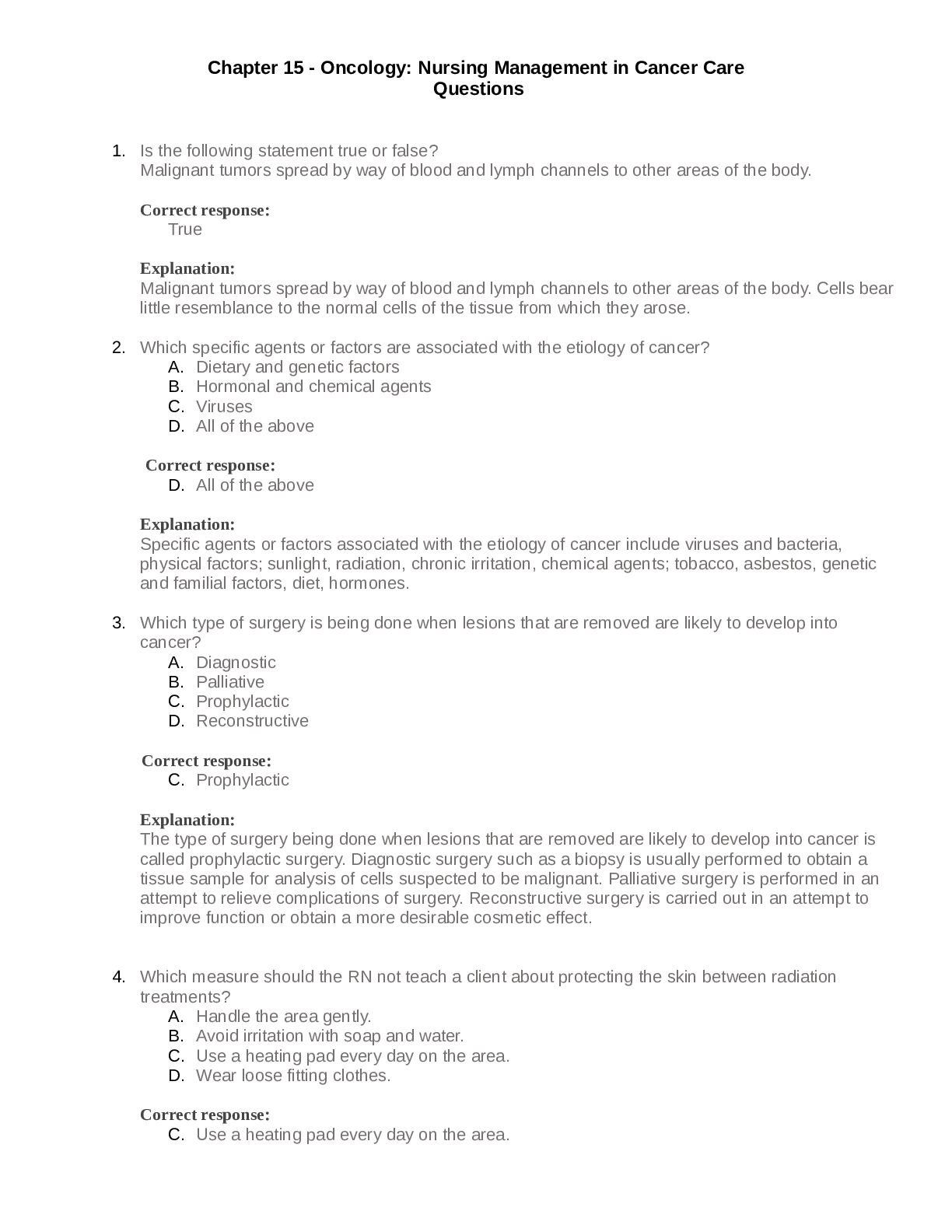Is the following statement true or false?
Malignant tumors spread by way of blood and lymph channels to other areas of the body.
Correct response:
True
Explanation:
Malignant tumors spread by way of blood and lymph channels to other areas of the body. Cells bear
little resemblance to the normal cells of the tissue from which they arose.
2. Which specific agents or factors are associated with the etiology of cancer?
A. Dietary and genetic factors
B. Hormonal and chemical agents
C. Viruses
D. All of the above
Correct response:
D. All of the above
Explanation:
Specific agents or factors associated with the etiology of cancer include viruses and bacteria,
physical factors; sunlight, radiation, chronic irritation, chemical agents; tobacco, asbestos, genetic
and familial factors, diet, hormones.
3. Which type of surgery is being done when lesions that are removed are likely to develop into
cancer?
A. Diagnostic
B. Palliative
C. Prophylactic
D. Reconstructive
Correct response:
C. Prophylactic
Explanation:
The type of surgery being done when lesions that are removed are likely to develop into cancer is
called prophylactic surgery. Diagnostic surgery such as a biopsy is usually performed to obtain a
tissue sample for analysis of cells suspected to be malignant. Palliative surgery is performed in an
attempt to relieve complications of surgery. Reconstructive surgery is carried out in an attempt to
improve function or obtain a more desirable cosmetic effect.
4. Which measure should the RN not teach a client about protecting the skin between radiation
treatments?
A. Handle the area gently.
B. Avoid irritation with soap and water.
C. Use a heating pad every day on the area.
D. Wear loose fitting clothes.
Correct response:
C. Use a heating pad every day on the area.
Explanation:
Measures to protect a client’s skin between radiation treatments include handling the area gently,
avoiding irritation with soap and water, and wearing loose-fitting clothing. The client should not use
a heating pad every day on the area because it will not promote tissue repair.
5. Is the following statement true or false?
The most common cause of bleeding in cancer patients is thrombocytopenia.
Correct response:
True
Explanation:
The most common cause of bleeding in cancer patients is thrombocytopenia.
After cancer chemotherapy, a client experiences nausea and vomiting. The nurse should
assign highest priority to which intervention?
You Selected:
Administering metoclopramide and dexamethasone as ordered
Correct response:
Administering metoclopramide and dexamethasone as ordered
Explanation:
The nurse should assign highest priority to administering an antiemetic, such as
metoclopramide, and an anti-inflammatory agent, such as dexamethasone, because it
may reduce the severity of chemotherapy-induced nausea and vomiting. This
intervention, in turn, helps prevent dehydration, a common complication of
chemotherapy. Serving small portions of bland food, encouraging rhythmic breathing
exercises, and withholding fluids for the first 4 to 6 hours are less likely to achieve this
outcome.
Reference:
Hinkle, J.L., and Cheever, K.H. Brunner & Suddarth's Textbook of Medical-Surgical
Nursing, 13th ed. Philadelphia: Lippincott Williams & Wilkins, 2014, Chapter 15:
Oncology: Nursing Management in Cancer Care, p. 332.
Chapter 15: Oncology: Nursing Management in Cancer Care - Page 332
Question 2 See full question
Which statement by a client undergoing external radiation therapy indicates the need for
further teaching?
You Selected:
"I'm worried I'll expose my family members to radiation."
Correct response:
"I'm worried I'll expose my family members to radiation."
Explanation:
The client undergoing external radiation therapy requires further teaching when he
voices a concern that he might expose his family to radiation. Internal radiation, not
external radiation, poses a risk to the client's family. The client requires no further
teaching if he states that he should wash his skin with mild soap and water, wear
protective clothing when outside, and avoid using a heating pad.
Reference:
Hinkle, J.L., and Cheever, K.H. Brunner & Suddarth's Textbook of Medical-Surgical
Nursing, 13th ed. Philadelphia: Lippincott Williams & Wilkins, 2014, Chapter 15:
Oncology: Nursing Management in Cancer Care, p. 328.
Chapter 15: Oncology: Nursing Management in Cancer Care - Page 328
Question 3 See full question
During which step of cellular carcinogenesis do cellular changes exhibit increased
malignant behavior?
Read More
.png)

